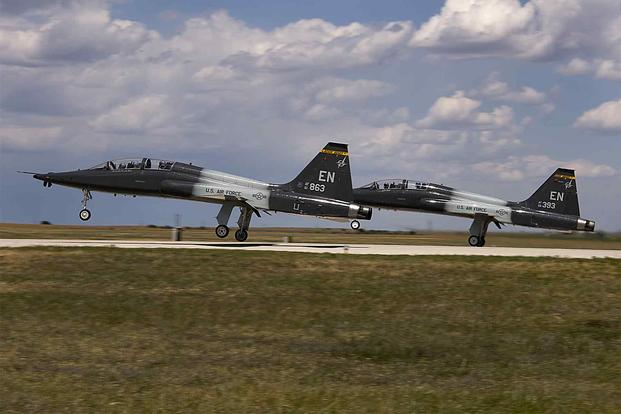A fatal T-38C Talon crash in February was caused by mistakes made by both the Air Force instructor pilot and the Japanese student pilot on board, a newly released investigation found.
Instructor pilot 1st Lt. Scot Ames Jr. and Renshi Uesaki of the Japanese Air Self-Defense Force died during a Feb. 19 training flight when their jet trainer hit the ground short of the runway at Montgomery Regional Airport in Alabama. The two were part of the 50th Flying Training Squadron, 14th Flying Training Wing, at Columbus Air Force Base in Mississippi.
The investigation report, which the Air Force posted online Thursday, said the pilots were trying to circle into the airport using the aircraft's instruments. But the T-38 was going faster than it was supposed to and undershot the final turn.
Ames told Uesaki to turn the aircraft to line up with the runway for a final approach and slow down, the report found. But the T-38 slowed below the appropriate final approach speed. Ames took control of the aircraft and put the throttles to maximum afterburner in an attempt to recover.
But by that point, the report said, the throttles had been idle for 18 seconds. The plane had slowed even further and was descending rapidly. It hit the ground approximately 1,800 feet from the runway at about 4:40 p.m., fatally injuring both pilots. Neither had attempted to eject.
Read Next: Marines, Special Ops Troops Secretly Deploying to Taiwan Amid China Tensions, Report Says
The investigator concluded that Ames, who was on his first assignment as an instructor pilot, lost situational awareness on the final approach. He didn't realize in time that Uesaki had left the throttles idle for too long and did not react quickly enough to fix the dangerous situation that was unfolding, according to the report.
The report added that Uesaki contributed to the crash by becoming "task saturated" and placing, and then leaving, the throttles in idle.
The investigation report called this a highly unusual move for a student pilot to make in the T-38. Several instructor pilots told investigators "they would be very uncomfortable" if a student pilot put the throttles in idle at any point in the final turn of such an approach. Instructors typically keep a close eye on student pilots' throttle movements when close to the ground and stay ready to jump in quickly if a mistake is made, the report said.
Ames was well-respected by his leaders and colleagues as one of the best first-assignment instructor pilots in the squadron, the report said. But due to a winter storm, he had not flown for nine days before the fatal flight.
Witnesses told investigators that after the nine-day break, Ames was rested and excited to fly the mission, which would have continued on to Tallahassee International Airport in Florida.
But some uncharacteristic irregularities during mission planning and ground operations suggested Ames "may also have lost some amount of proficiency in the days he was out of the cockpit," the report added.
He wasn't present for the weather briefing before the flight, didn't calculate how much extra fuel would be needed to reach an alternate airfield if weather prevented them from safely reaching Tallahassee, and didn't realize the aircraft -- which had just had an engine replaced -- should have flown a local flight before the "cross-country" training sortie to another base, the report found.
Those mistakes didn't directly contribute to the crash, according to the report, but they point to Ames' "lack of attention to detail" the day of the crash, and a possible lack of appreciation for the risk involved in the student cross-country mission.
-- Stephen Losey can be reached at stephen.losey@military.com. Follow him on Twitter @StephenLosey.
Related: Air Force Base Halts Flight Operations After 2 Killed in Alabama T-38 Jet Crash














